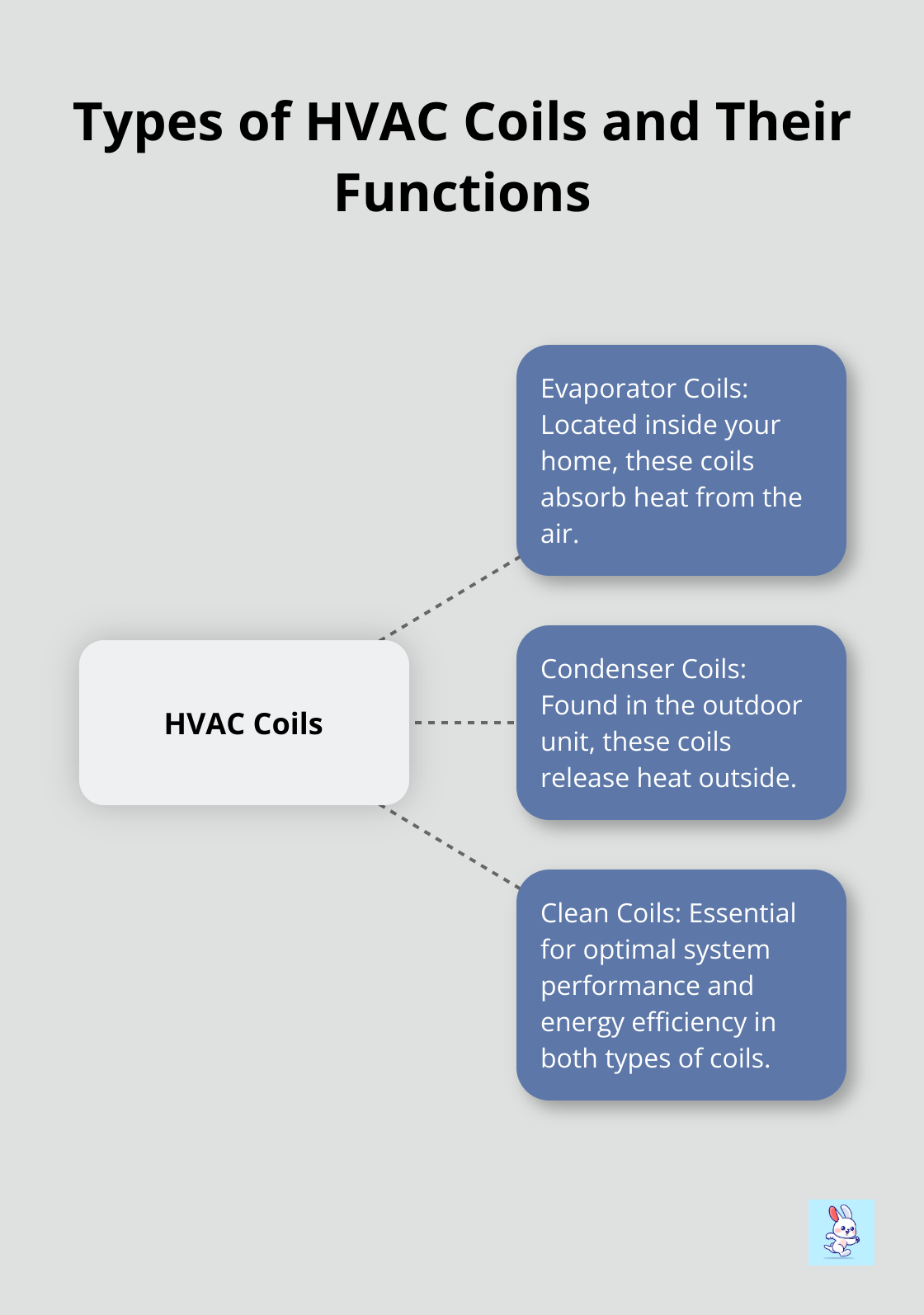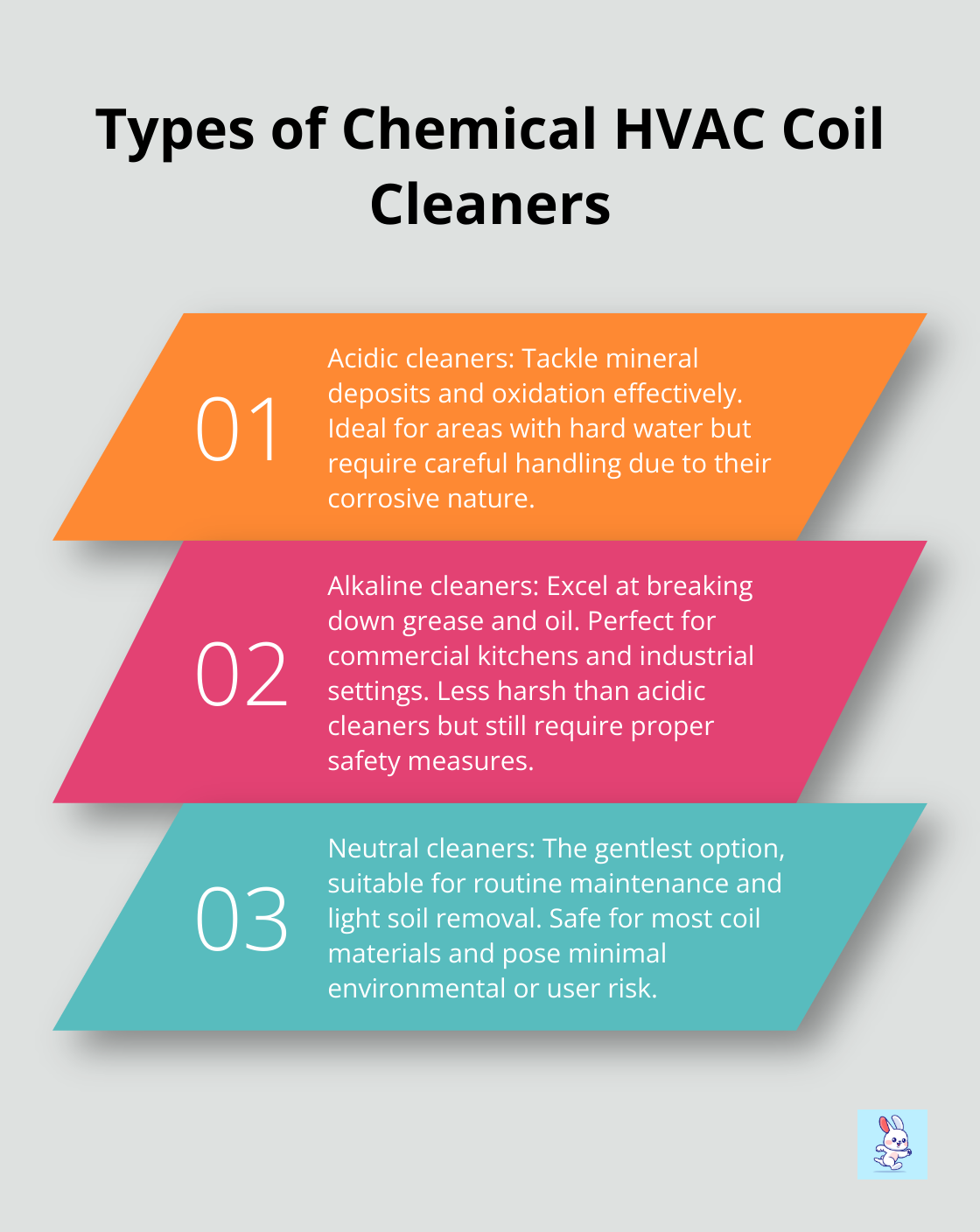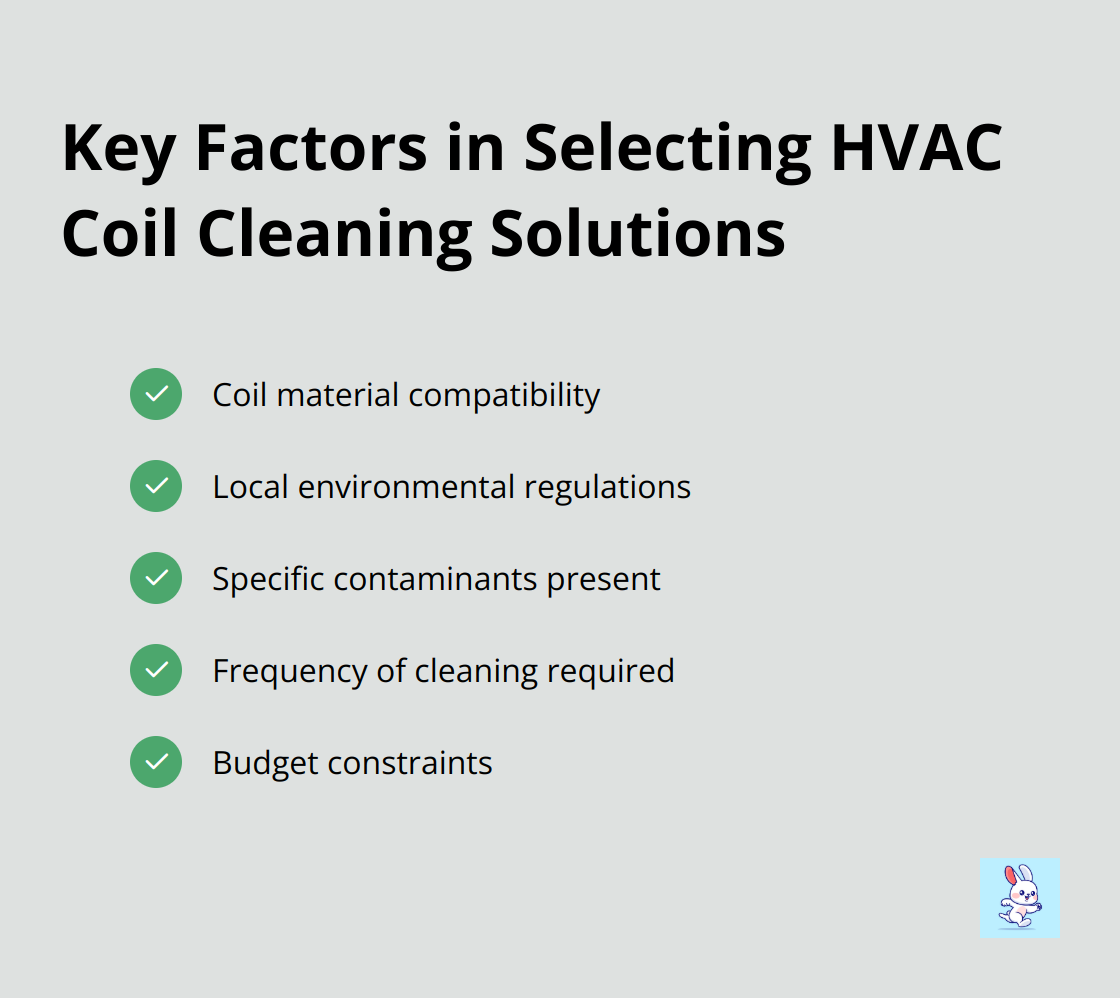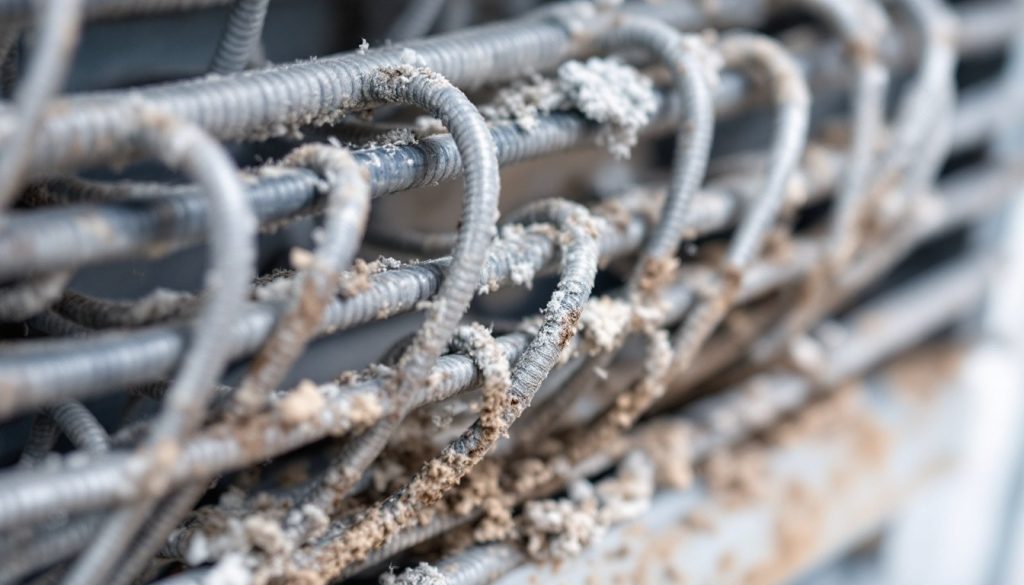At Cleaning Rabbit, we know that maintaining clean HVAC coils is essential for optimal system performance and energy efficiency.
Choosing the right cleaning solution can make a significant difference in the effectiveness of your HVAC dryer vent cleaning and overall system maintenance.
In this post, we’ll explore the various types of HVAC coil cleaning solutions and provide practical tips to help you select the best option for your needs.
Why Clean HVAC Coils Matter
The Energy Efficiency Connection
Clean HVAC coils are the unsung heroes of energy efficiency and indoor air quality. Neglected coils can lead to a host of problems. Dirty, clogged filters reduce airflow and system efficiency. When airflow is obstructed, dirt can bypass the filter and accumulate on the evaporator coil, forcing your system to work harder and consume more energy for the same cooling effect.
Types of Coils and Their Functions
HVAC systems typically feature two main types of coils:
- Evaporator coils: Located inside your home, these coils absorb heat from the air.
- Condenser coils: Found in the outdoor unit, these coils release heat outside.
Both play critical roles in the heat exchange process, and their cleanliness directly impacts system performance.

Common Coil Contaminants
Coils attract various contaminants. In Las Vegas and Henderson, common culprits include:
- Dust and pollen: These airborne particles accumulate quickly, especially in desert climates.
- Grease and oil: Common in commercial settings, these create a sticky surface that traps more debris.
- Microbial growth: Moisture on dirty coils can lead to mold and bacteria, affecting indoor air quality.
Regular cleaning prevents these contaminants from insulating the coils and impeding heat transfer. The Environmental Protection Agency (EPA) recommends cleaning coils as part of routine HVAC maintenance to maintain system efficiency and indoor air quality.
The Impact on System Longevity
Dirty coils don’t just affect performance; they can shorten your HVAC system’s lifespan. When coils become clogged, the system strains to maintain desired temperatures. This extra work can lead to premature wear and tear on components like the compressor, potentially resulting in costly repairs or replacements.
Properly maintained coils can extend system life by several years (translating to significant savings for homeowners and businesses alike).
The Role of Professional Cleaning
While some homeowners attempt DIY coil cleaning, professional services (like those offered by Cleaning Rabbit) ensure thorough and safe cleaning. Professionals use specialized equipment and cleaning solutions tailored to different coil types and contaminants. This expertise not only improves system efficiency but also helps prevent accidental damage during the cleaning process.
Now that we understand the importance of clean HVAC coils, let’s explore the various types of cleaning solutions available to tackle this essential maintenance task.
What Are the Best HVAC Coil Cleaning Solutions?
Chemical Cleaners: A Powerful Trio
HVAC coil cleaning solutions come in various forms, each with unique strengths. Chemical cleaners stand out as a versatile option, offering three distinct types:

Eco-Friendly Alternatives
The push for environmentally responsible cleaning has sparked the development of biodegradable and eco-friendly options. These products break down naturally, reducing their environmental footprint.
Many eco-friendly cleaners utilize plant-based ingredients or enzymes to dissolve dirt and grime. They may require longer application times compared to traditional chemical cleaners, but they offer a safer alternative for technicians and building occupants alike.
The EPA’s Safer Choice program has recognized several eco-friendly coil cleaners.
High-Pressure Cleaning: Water and Steam
For those seeking a chemical-free approach, pressurized water and steam cleaning methods offer effective solutions. These techniques work particularly well for outdoor units exposed to heavy debris.
High-pressure water cleaning employs a specialized nozzle to direct a powerful stream through the coils, dislodging dirt and debris. This method delivers quick results but requires precise control to avoid damaging delicate fin structures.
Steam cleaning elevates this concept by using high-temperature vapor to clean and sanitize coils. The heat from steam effectively kills bacteria and mold, addressing both cleanliness and indoor air quality concerns.
Regular and deep steam coil cleaning not only improves energy efficiency but also extends the lifespan of HVAC equipment, reduces maintenance costs, and improves indoor air quality.
Factors to Consider in Solution Selection
When choosing a cleaning solution, several factors come into play:
- Coil material compatibility
- Local environmental regulations
- Specific contaminants present
- Frequency of cleaning required
- Budget constraints
For complex systems or persistent issues, professional services can provide tailored recommendations and ensure the most appropriate and effective cleaning method for your HVAC coils.
As we move forward, let’s explore the key considerations that will help you make an informed decision when selecting the ideal HVAC coil cleaning solution for your specific needs.
How to Pick the Perfect HVAC Coil Cleaner
Material Compatibility: A Top Priority
The selection of an HVAC coil cleaning solution must start with material compatibility. Aluminum fins, which are common in most systems, can react negatively to highly acidic or alkaline cleaners. Copper coils, while more robust, also require careful cleaner selection. Always consult your HVAC manufacturer’s guidelines for specific recommendations.
The ASHRAE Standard 170-2013 provides guidelines for ventilation of health care facilities, which includes considerations for HVAC systems. While this standard is specific to healthcare settings, it underscores the importance of proper HVAC maintenance and cleaning across various applications.
Environmental Impact and Regulations
In water-conscious areas like Las Vegas and Henderson, low-water or no-rinse solutions are preferable. These products conserve water and reduce potential runoff issues.
Many states regulate volatile organic compounds (VOCs) in cleaning products. The EPA conducts studies on VOC emissions into ambient air, which informs regulations on cleaning products. Selecting low-VOC cleaners improves indoor air quality and reduces environmental impact.
Application Methods and Equipment
The choice of cleaner should take into account the application method and required equipment. Some solutions need specialized sprayers or foamers, while others work with a simple garden sprayer. DIY enthusiasts should look for products that don’t require professional-grade equipment.
Foaming cleaners can be particularly effective for hard-to-reach coils. They adhere to vertical surfaces, which allows for better penetration and cleaning power. However, these may require more thorough rinsing.
Cost-Effectiveness and Energy Savings
While cheaper cleaners might seem attractive, quality products often lead to significant long-term benefits. More effective cleaners can result in substantial energy savings over time.
Regular maintenance with high-quality cleaners can lead to lower energy bills and extended equipment life (a win-win for homeowners and businesses alike).
Professional vs. DIY Cleaning
The decision between professional and DIY cleaning depends on several factors. Professional services (like those offered by CleaningRabbit) often have access to specialized equipment and solutions that might not be available to the average homeowner. They also bring expertise in handling different types of HVAC systems.
DIY cleaning can be cost-effective for routine maintenance, but complex issues or older systems might benefit from professional attention. Always prioritize safety and follow manufacturer guidelines when attempting DIY coil cleaning.

Final Thoughts
The right HVAC coil cleaning solution maintains optimal system performance and energy efficiency. We explored chemical cleaners, eco-friendly alternatives, and high-pressure methods. Your choice should match specific needs, considering coil material compatibility, environmental impact, application ease, and long-term cost-effectiveness.
Regular maintenance, including HVAC dryer vent cleaning, keeps your system running smoothly. A consistent cleaning schedule prevents contaminant buildup, improves indoor air quality, and extends HVAC equipment lifespan. This approach ensures better performance and leads to significant energy savings over time.
Cleaning Rabbit specializes in comprehensive HVAC cleaning services. Our team uses advanced HEPA-filtered equipment and personalized care to enhance your home’s comfort and safety. We serve Las Vegas and Henderson with transparent, honest service (without hidden fees).

